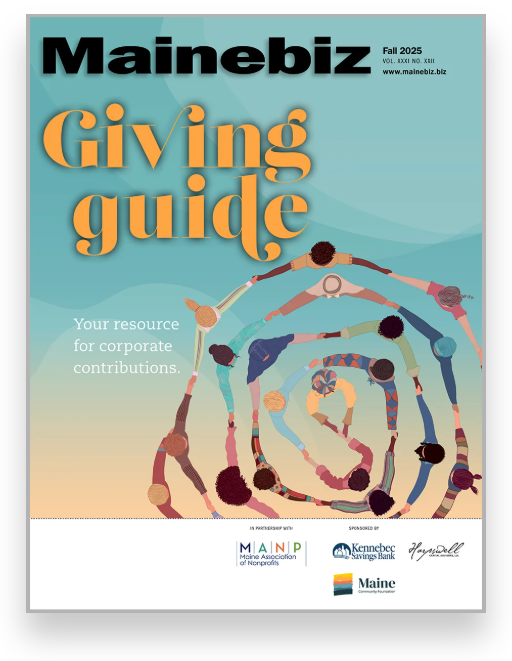Processing Your Payment
Please do not leave this page until complete. This can take a few moments.
- News
-
Editions
-
- Lists
-
Viewpoints
-
Our Events
-
Award Honorees
- 2025 Business Leaders of the Year
- 2025 Outstanding Women in Business
- 2024 40 Under 40 Honorees
- 2024 Women to Watch Honorees
- 2024 Business Leaders of the Year
- 2023 NextUp: 40 Under 40 Honorees
- 2023 Women to Watch Honorees
- 2023 Business Leaders of the Year
- 2022 NextUp: 40 Under 40 Honorees
- 2022 Women to Watch Honorees
- 2022 Business Leaders of the Year
-
-
Calendar
-
Biz Marketplace
- News
-
Editions
View Digital Editions
Biweekly Issues
- September 22, 2025
- September 8, 2025
- August 25, 2025
- August 11, 2025
- July 28, 2025
- July 14, 2025
- + More
Special Editions
- Lists
- Viewpoints
- Our Events
- Calendar
- Biz Marketplace
20 on '20: Lobster fishery remains strong, but whale regulation looms
 Photo / Laurie Schreiber
Kristan Porter, president of the Maine Lobstermen’s Association, predicts the fishery will remain stable through 2020 but could experience some upheaval with new rules to protect the North Atlantic right whale.
Photo / Laurie Schreiber
Kristan Porter, president of the Maine Lobstermen’s Association, predicts the fishery will remain stable through 2020 but could experience some upheaval with new rules to protect the North Atlantic right whale.
Maine’s lobster fishing industry faces a new round of potentially drastic modifications to its gear in order to protect the endangered North Atlantic right whale. The industry also grappled this year with a shortage of herring, the fishery’s favored bait.
But the fishery has been generally stable over the past year and is expected to remain so through 2020, says Kristan Porter, president of the Maine Lobstermen’s Association.
“If you’re in a wild-caught fishery, you’re always wondering what the catch will be in the next year, whether it will be early or late, what the price will be, what your expenses are going to be,” he says.
Maine’s lobster fetched $484.5 million in 2018 — the largest share of the overall fishery, which was worth $637.1 million in 2018.
The final numbers aren’t in yet for 2019 landings. But lobsters were slow to arrive July through September, and it’s expected landings will show a decrease from 2018’s 119.6 million pounds, although there’s some expectation that strong catches October through December could make up for the lower summertime landings, he says.
“As a state, the catch will probably be down some,” Porter says. “But it’s not going to be drastic ... We’re coming off a series of record catches. I don’t think anyone thinks we can break records year after year after year.”
Even if the catch is down, prices are up at least 20% to 25% over 2018, pushed by strong demand.
In 2020, the industry will continue to work with the Maine Lobster Marketing Collaborative to build demand and prices, with a focus on the domestic market, he says.
The industry has its eye on potenial new regulations aimed at protecting right whales. For now, aside from additional markings on gear, the bulk of regulations would not hit in 2020.
“That’s looming,” Porter says. “I don’t know what we can do other than wait and see what the feds propose.” New federal rules in 2021 might require more traps per line in order to reduce the number of vertical lines in the water.
“We’re optimistic for next year,” Porter says. “Like anything, you don’t know what’s going to happen going in, especially in a fishery that’s controlled by Mother Nature. We do the best we can to manage it correctly, but there’s always uncertainty.”
Mainebiz web partners

The Giving Guide
The Giving Guide helps nonprofits have the opportunity to showcase and differentiate their organizations so that businesses better understand how they can contribute to a nonprofit’s mission and work.
Learn More
Work for ME
Work for ME is a workforce development tool to help Maine’s employers target Maine’s emerging workforce. Work for ME highlights each industry, its impact on Maine’s economy, the jobs available to entry-level workers, the training and education needed to get a career started.
Learn More
Groundbreaking Maine
Whether you’re a developer, financer, architect, or industry enthusiast, Groundbreaking Maine is crafted to be your go-to source for valuable insights in Maine’s real estate and construction community.
Learn more-
The Giving Guide
The Giving Guide helps nonprofits have the opportunity to showcase and differentiate their organizations so that businesses better understand how they can contribute to a nonprofit’s mission and work.
-
Work for ME
Work for ME is a workforce development tool to help Maine’s employers target Maine’s emerging workforce. Work for ME highlights each industry, its impact on Maine’s economy, the jobs available to entry-level workers, the training and education needed to get a career started.
-
Groundbreaking Maine
Whether you’re a developer, financer, architect, or industry enthusiast, Groundbreaking Maine is crafted to be your go-to source for valuable insights in Maine’s real estate and construction community.
ABOUT
NEW ENGLAND BUSINESS MEDIA SITES
No articles left
Get access now
In order to use this feature, we need some information from you. You can also login or register for a free account.
By clicking submit you are agreeing to our cookie usage and Privacy Policy
Already have an account? Login
Already have an account? Login
Want to create an account? Register
Get access now
In order to use this feature, we need some information from you. You can also login or register for a free account.
By clicking submit you are agreeing to our cookie usage and Privacy Policy
Already have an account? Login
Already have an account? Login
Want to create an account? Register






0 Comments